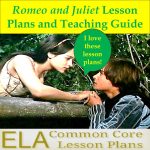Romeo and Juliet Cause and Effect Lesson Plan
You could spend an entire semester examining cause and effect in Romeo & Juliet, but your students would get bored. Instead, try this cause and effect lesson plan that involves writing a cause and effect paper using incidents from the play as evidence. By the way, you can use this lesson plan with just about any piece of literature.
A Tragedy in the Classroom
Things were going well until Paula Wetsock in the second row asked, “Mr. Leaveteaching, I understand you worked very hard on teaching cause and effect in Romeo & Juliet and that you probably spent hours on this cause and effect lesson plan, but it’s really boring. I’m sure your principal could come up with a better cause and effect lesson plan. Maybe you could have us write a cause and effect paper analyzing cause and effect in Romeo & Juliet, for example.”
“So you think that idiot principal of mine, could create a better cause and effect lesson plan and teach cause and effect in Romeo & Juliet better than me,” I responded before noticing my principal was standing right behind me.
He handed me two papers: the first one said cause: you calling me an idiot; effect: you getting fired; the second one was a writing a cause and effect paper lesson plan that I’m going to share with you.
Assignment Options

Click the pic and check out the 8-12 week Romeo and Juliet unit plan and teaching guide.
Determining blame in Romeo and Juliet can be done with any of the following assignments. The procedures for writing a cause and effect paper on the teens’ death will be provided. Click on the links for a more detailed explanation of other ideas.
- Write an official report of the events leading up to Romeo and Juliet’s death. The purpose is to help Prince Escalus and other dignitaries of Verona make sense of the double suicide.
- Put Friar Lawrence and other characters on trial.
- Write a cause and effect essay assessing blame to the proper individuals.
- Conduct a group activity ranking the characters in order of guilt.
Writing Procedures
- Prewriting - Summarize the plot. This can be done as a class, in small groups, or individually. Make sure students list the chain of events leading to the deaths.
- Prewriting - Identify cause and effect. Once the events are listed, determine which events caused which events.
- Drafting - Make sure you target your audience-in this case Prince Escalus, a man who could banish you, imprison you, or have you killed on a whim. Your tone should be respectful.
- Drafting - Focus on the facts. Leave out emotion. This is an official report. Only note what you observed or read.
- Revising - Look at your transitions. Transition words that signal cause and effect (consequently, therefore, hence) should be present.
- Revising - Have a partner read your report. Make sure you’ve included all major events. Be sure the report is clear and would make sense to someone not familiar with the facts (perhaps you could find someone under a rock not familiar with the play to help you revise). Make sure you reveal what you believe to be the underlying cause of the outcome. Check your tone; you’re talking to a prince.
ELA Common Core Standards Covered
Teaching cause and effect with this lesson plan covers the following ELA Common Core Standards.
- RL.9-10.1 Cite strong and thorough textual evidence to support analysis of what the text says explicitly as well as inferences drawn from the text.
- RL.9-10.2 Determine a theme or central idea of a text and analyze in detail its development over the course of the text, including how it emerges and is shaped and refined by specific details; provide an objective summary of the text.
- RL.9-10.6 Analyze a particular point of view or cultural experience reflected in a work of literature from outside the United States, drawing on a wide reading of world literature.
- Common Core Writing Standard 1. Write arguments to support claims in an analysis of substantive topics or texts, using valid reasoning and relevant and sufficient evidence.
- Common Core Writing Standard 2. Write informative/explanatory texts to examine and convey complex ideas, concepts, and information clearly and accurately through the effective selection, organization, and analysis of content.
- W.9-10.4 Produce clear and coherent writing in which the development, organization, and style are appropriate to task, purpose, and audience. (Grade-specific expectations for writing types are defined in W.9-10.1-3.)
- W.9-10.5 Develop and strengthen writing as needed by planning, revising, editing, rewriting, or trying a new approach, focusing on addressing what is most significant for a specific purpose and audience. (Editing for conventions should demonstrate command of L.9-10.1-3.)
- W.9-10.9 Draw evidence from literary or informational texts to support analysis, reflection, and research.
- W.9-10.9a Apply grades 9-10 Reading standards to literature (e.g., “Analyze how an author draws on and transforms source material in a specific work [e.g., how Shakespeare treats a theme or topic from Ovid or the Bible or how a later author draws on a play by Shakespeare]”).
Romeo and Juliet Lesson Plans
Students will respond positively to Romeo and Juliet if they are engaged.
- Strategies for Analyzing Shakespeare
- Romeo and Juliet Cause and Effect Lesson Plan
- Teaching Characterization with Romeo and Juliet
- Romeo and Juliet Shields
- Character Interview
- Romeo and Juliet Writing Activity
- Romeo and Juliet Irony Lesson Plan